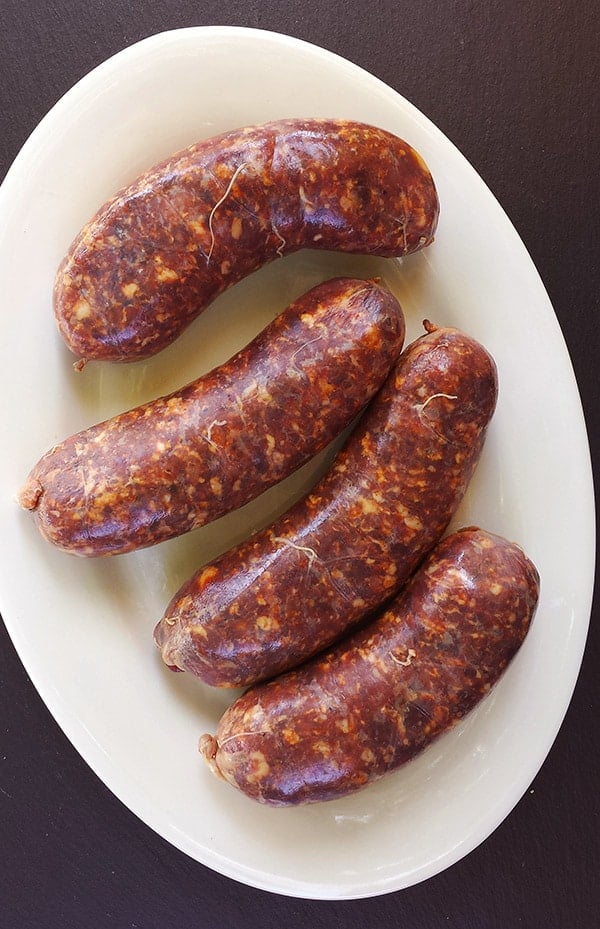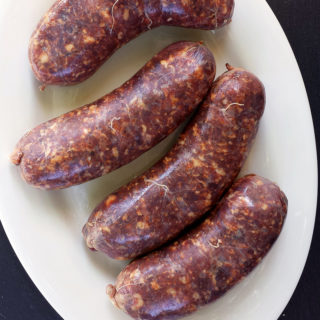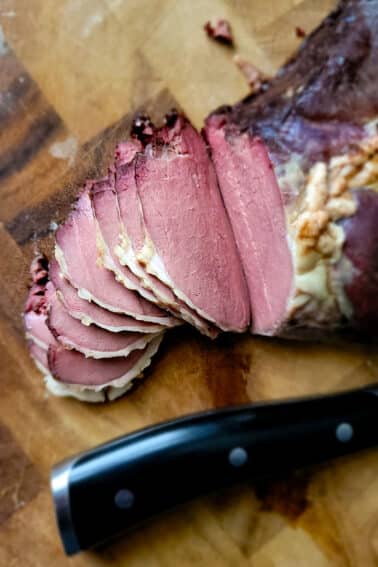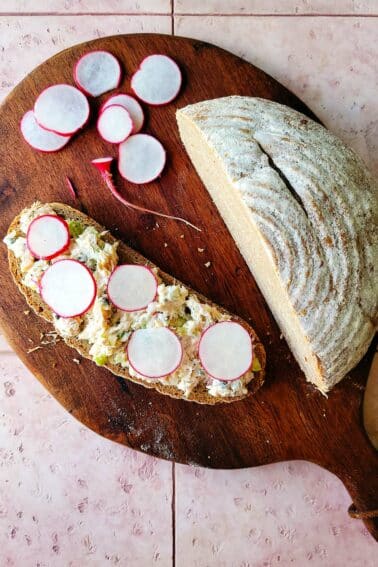As an Amazon Associate I earn from qualifying purchases.

Chorizo sausage is the default in many Spanish-speaking countries, and everyone seems to have a different version. For the most part, Spanish chorizo is a hard, dry cured sausage, while Mexican chorizo is fresh, and tends to be pretty soft, almost spreadable — best uncased and mixed with eggs and such.
Argentina has its own version of chorizo sausage that’s a happy medium between the two. Chorizo Argentino a “normal” fresh sausage, with a consistency more or less like a typical Italian sausage we all know here in America.
How do they eat it? As a magical sandwich called choripán. As you might guess, the name is a mashup of chorizo and pan, meaning bread. Choripán is just a nice roll with a grilled chorizo in it, topped with chimichurri, the Argentine salsa of choice. (I have a link to my chimichurri recipe here.)
It’s an easy sausage to make. Rustic, meaning coarsely ground, with lots of black pepper, paprika and garlic, moistened with red wine — Malbec, if you want to stay Argentinean.
Typically the links are fat, so use wide hog casings if you can find them locally. I can’t, so I use these casings from The Sausage Maker.
Of course, you can serve your chorizo any way you want, but grilled over wood with homemade chimichurri is pretty hard to beat.
I like to make these with a combination of venison and pork, but you could make them from pretty much anything. The bacon ends I use add some smokiness and salt to the party, but you can use straight pork fat if you’d prefer. If you do, increase the salt to 36 grams. Conversely, if you are using especially salty bacon, drop the added salt. Use your judgment.
Keep in mind this is chorizo Argentino. There are other versions. Here is my Mexican chorizo recipe, and there’s also a dry cured, Spanish chorizo, which is a bit harder to make.
New to making sausage? You can find my detailed tutorial on how to make sausages at home here.
Chorizo Argentino Sausage
Ingredients
- 2 1/4 pounds pork shoulder
- 3/4 pound bacon ends (or chopped bacon)
- 2 pounds venison or beef
- 30 grams kosher salt
- 5 teaspoons coarsely ground black pepper
- 3 tablespoons paprika
- 3 to 5 garlic cloves, minced, about 2 tablespoons
- 3/4 cup red wine
- Hog casings
Instructions
- Get out about 10 feet of hog casings and soak them in warm water.
- Cut the meat and bacon into chunks you can fit into your meat grinder. Mix the salt with the meats and bacon until every piece has a little on it. Refrigerate overnight if you want, but let it sit in the fridge at least an hour or so; this helps develop myosin in the mixture, which helps the texture of the finished sausage. When you are ready to grind, add all the other spices and mix well. Put the meat in the freezer until it is between 30°F and 40°F. Put your grinder parts (auger, dies, blades, etc) in the freezer, too, and put a bowl in the fridge.
- If you have multiple dies for your grinder, grind one-quarter of the mixture through a very coarse die, say, 9 mm. Grind the rest through a 6.5 mm die. If you don't have anything larger than a 6.5 mm, which is the standard "coarse" die, just use it. If your meat mixture is still at 35°F or colder, you can go right to binding. If it has heated up, you need to chill everything back down. Use this time to clean up the grinder.
- Once the meat is cold, put it in a large bin or bowl and add the wine. Mix well with your (very clean) hands for 2 to 3 minutes — a good indicator of temperature is that your hands should ache with cold when you do this. You want to to mix until the meat binds to itself. You can also do this in a stand mixer set on its lowest setting, but I find you don’t get as good a bind as you do when you do it by hand.
- You now have chorizo. Now you need to stuff the links. Stuffing sausage is easier with two people, one to fill the links, the other to coil, but I do it solo all the time. Stuff the links well but not super-tight, as you will not be able to tie them off later if they are too full. Don’t worry about air pockets yet. Stuff the casing until you get a coil, leaving lots of room on either end to tie them off; I leave at least three inches of unstuffed casing on either end of the coil. Tie off one end of the coil. Pinch off 6-inch links with your fingers. Roll the sausage away from you a few times. Move down the coil and pinch off two more links. This time roll the sausage toward you a few times. Repeat until you have all the links made, then tie off the other end of the coil. (Here is a short video about the process.)
- Gently compress the sausage links from either end, twisting them a few more times in the direction you did initially. Look for air pockets. To remove them, set a large needle or a sausage pricker into a stovetop burner until it glows (this sterilizes it), then pierce the casing at the air pockets. Keep gently compressing and twisting the links, pricking out any little air pockets until they're gone.
- Hang your links for an hour or so to dry. You can do this overnight in a fridge if you want. Once dried a bit, the chorizo can be refrigerated for up to a week, or frozen for up to a year.
Notes
Nutrition
Nutrition information is automatically calculated, so should only be used as an approximation.






Hey Hank – Is there any harm in using a higher proportion of venison to pork shoulder? For example, do you think the taste of texture would suffer if I used 1.25lbs pork, .75lbs bacon ends, 3lbs venison? Thanks
Jordan: The only “harm” is fat content. You want a sufficient amount of fat in the grind.
Hola gracias por compartir la receta. Lo que se hace en Argentina es en a parrilla a las brasas (carbón cuando está blanco) tirar el chorizo dejarlo que se dore y pincharlo de cada lado con un tenedor para que pierda un poco de grasa. A mí personalmente el chorizo que más me gusta es el que llamamos aquí “mezcla” %60 cerdo %40 vaca. Y por supuesto acompañado del mejor malbec argentino. Saludos che !
Than you so much for sharing your recipe 🙂
“Stuart Wenham says
January 13, 2016 at 10:37 pm
Hi I made this recipe recently and they are tasty.I find that the fat is inclined to render out of the sausage and makes texture dry and coarse.”
And old post, I understand, but a common problem. What happened here is a broken emulsion. Your farce was over mixed and/or too warm. There is no saving it. It is critically important that you work quickly and keep everything cold while you mix. Your grinder assembly should be refrigerated as should your mixing bowl. If you are using a standing mixer, 1 minute on low to mix the seasoning and 1 minute on medium to mix the liquid is all you need. If you are doing it by hand it will take a little longer and you should nest your stainless steel mixing bowl in ice.
Hank.
Many years ago an Spanish priest told me that chorizo must be made with
100% pork meat and if you use other meats mixtures the word chorizo will
not apply to the end product,it will be a sausage with other name.
A couple years later he went to Spain and brought me a piece of real Spanish
chorizo and I did not like at all,have tasted the Mexican version and the
same,too spicy,seems to me that here in the Latin American countries we kind of like mild simpler versions. I will try your recipe,according to ingredients seems to render a tasty chorizo. Here in Costa Rica is made with pork,mayby to keep the Spanish tradition,I am not sure on this one. Thanks for sharing your recipe.
I’ve found that a very small amount of nutmeg, dry thyme and oregano are what gets you a spot on argentinian chorizo flavor profile
Do you have a recipe for the traditional rolls they are served on?
Shecktor: Nope. I am only a passingly competent baker, so you are on your own for that one.
Hi I made this recipe recently and they are tasty.I find that the fat is inclined to render out of the sausage and makes texture dry and coarse.
Is there something I am doing wrong? Or is this the intention?
Cheers Stu
P.s I also made the mexican version and found the same trouble
Stuart: It’s how you are cooking them. Or the fat you are using. This doesn’t happen when I cook them.
Thanks Hank! I look forward to trying it!
I’ve been making sausage for a few years now and am eager to give this recipe a try! Just wondering why you sterilize the needle for pricking air bubbles when nothing else is sterile? (It’s the former biologist in me curious to know.)
Debra: Because my needle is normally hanging around on a window sill before I use it.
This is probably a dumb question, but not being a hunter myself, and just being the beneficiary of free venison from a neighbor who does — I have LOTS of hamburger. Finding new and interesting recipe’s to utilize it is difficult. Could I use it for this recipe?
Jody: Yep. You can — if that burger has fat ground into it.
Dear Hank
Congratulations for your nice sausage. Seems to be also great for hot dogs. About the Paprika I suggest Spanish smoked Pimenton (smoked spanish paprika) from De-la-Vera. There are some brands that use Pimenton from De La Vera.I prefer the hot ones (they are not really so hot)” Pimenton Picante”; you can find them to buy in the internet if you are not close to a good delicatessen.
Best Regards
Alexandre from Rio de Janeiro Brazil
Grilled the chorizo tonight and had it with chimichuri and our first garden tomato. Amazing. I can’t wait to make a paella with the chorizo as a star ingredient. Thank you for the recipe.
I’m not knocking it – it sounds like a great recipe and I’m sure there’s some excellent smoked pimentón to be had close to home. I suspect the Spanish got the idea for smoking chiles from the Americas, which is where all the paprika came from originally.
Spanish chorizo comes in all forms – fresh, soft and friable (grillable) plus varying cured versions depending on age and whether they have been smoked or not. It’s not just made as a hard version. The best Spanish paprika is probably pimentón de la vera, which is smoked and comes from the area around the Tietar River in La Vera. There are probably some really good South American or Mexican equivalents. IMHO smoking the pimentón (paprika) gives it fantastic extra depth 🙂
Mad Dog: You are correct, of course. But this is a particular favorite in Argentina. And yes, if you can find it, pimenton de la vera is the primo stuff. I just wouldn’t want someone to not make this recipe just because they couldn’t find it.
Do you have a particular brand of paprika you’d recommend?
Nathan: Not really. Just make sure it’s bright red and smells nice. Paprika ages fast.
We have 20 people for lunch and would like to serve our homemade sausages.
If we would like to cook the sausages in the oven (instead of BBQ), what’s temperature and how long do you think? Thank you!
aakiki: Brown them in an oven-proof frying pan, then finish in a 350-degree oven for 15 minutes.
Dang, those look really good. I’ve wondered about making sausages with our rabbits and added pork fat. This would probably work.